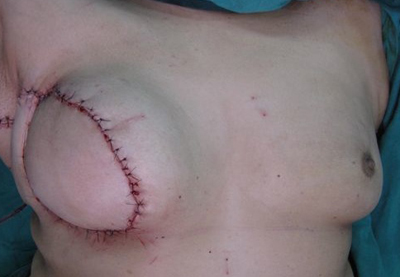Surgical removal remains the mainstay of treatment of a breast tumor. The decision to treat the patient with other modalities like chemotherapy and radiotherapy is taken on a case-to-case basis.
The patient with a breast tumor may need to undergo the following operations:
- Surgical removal of part or whole of the affected breastfollowed bysurgery to restore the breast form.This may be achieved bysurgically transferring “like” tissues from the patients own body or using an implant (internal prosthesis).
- Surgical removal of lymph gland(s) from the affected arm pit.This may result in swelling of hand on same side, for which surgical correction is possible.
- Surgical modification of the other breasts (at the same operation) for achieving an aesthetically symmetrical result may be required.
- Yes, depending on the amount of healthy breast glandular and ductal tissue that remains after tumor removal. Tissue transplanted from another area of the patients body only provides the “form”, not the “lactating function”. The “function” of the breast is not only to lactate, it has to “look” and “feel” like a breast as well!
- You will need to speak to a plastic surgeon experienced in breast reconstruction. Ask your physician or breast surgeon regarding the same.
- 4. What are the advantages of transplanting tissue from one’s own body over implantation of a breast prosthesis?Answer
- “Own” or “autologous” tissue has the inherent advantage of providing a natural result. Moreover, autologous tissue is able to tolerate radiation better than an implanted breast prosthesis. You may get a taut abdomen in the bargain. In certain situations, a prosthesis may be applicable. Ask your breast surgeon today.
- 5. Do I need to get any more surgeries other than the one required at the time of my tumor removal?Answer
- Yes, it is possible. In order to achieve symmetrical breasts modification surgeries may be required/mandated.
| Types of breast reconstruction | |
|---|---|
| Removal of breast tissue | Surgery for restoration of breast form |
| Complete removal of breast tissue(Total mastectomy) | Transplant of skin and fat from patient’s abdomen or Implantation of a prosthesis |
| Partial removal (Lumpectomy with conservation of breast tissue and skin) | Surgical reorientation of remaining breast tissue or transfer from surrounding area |





